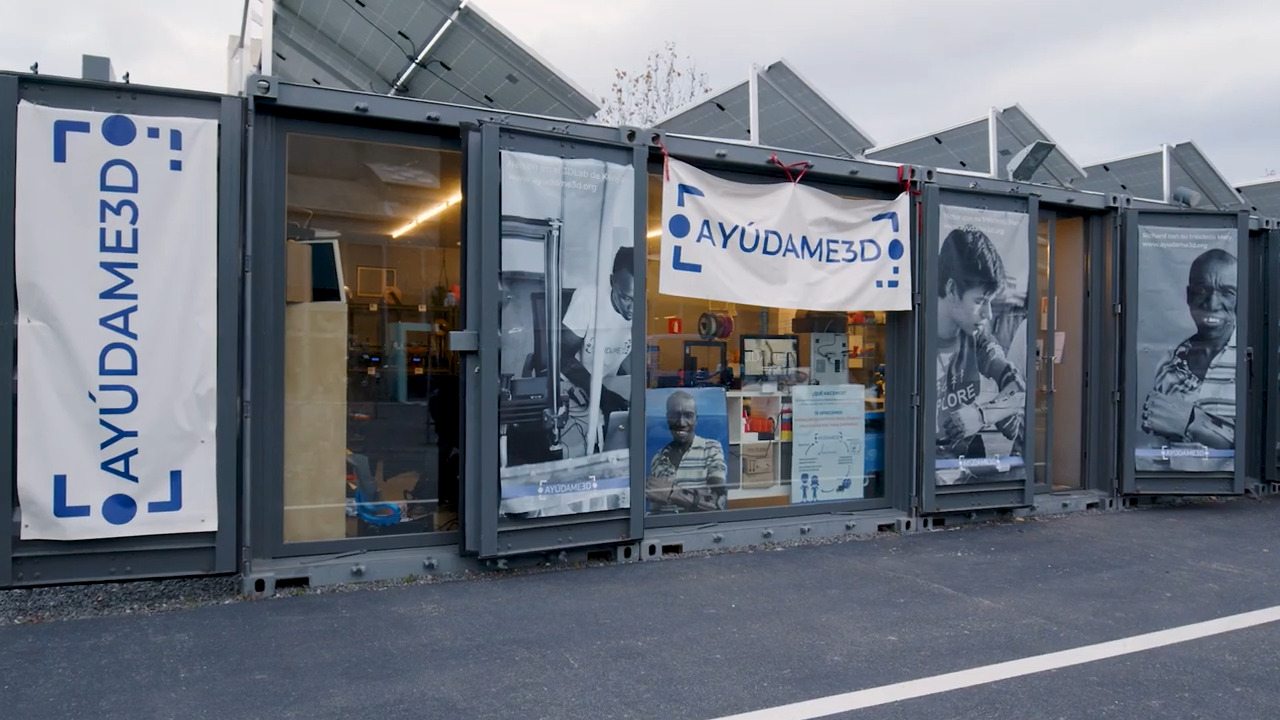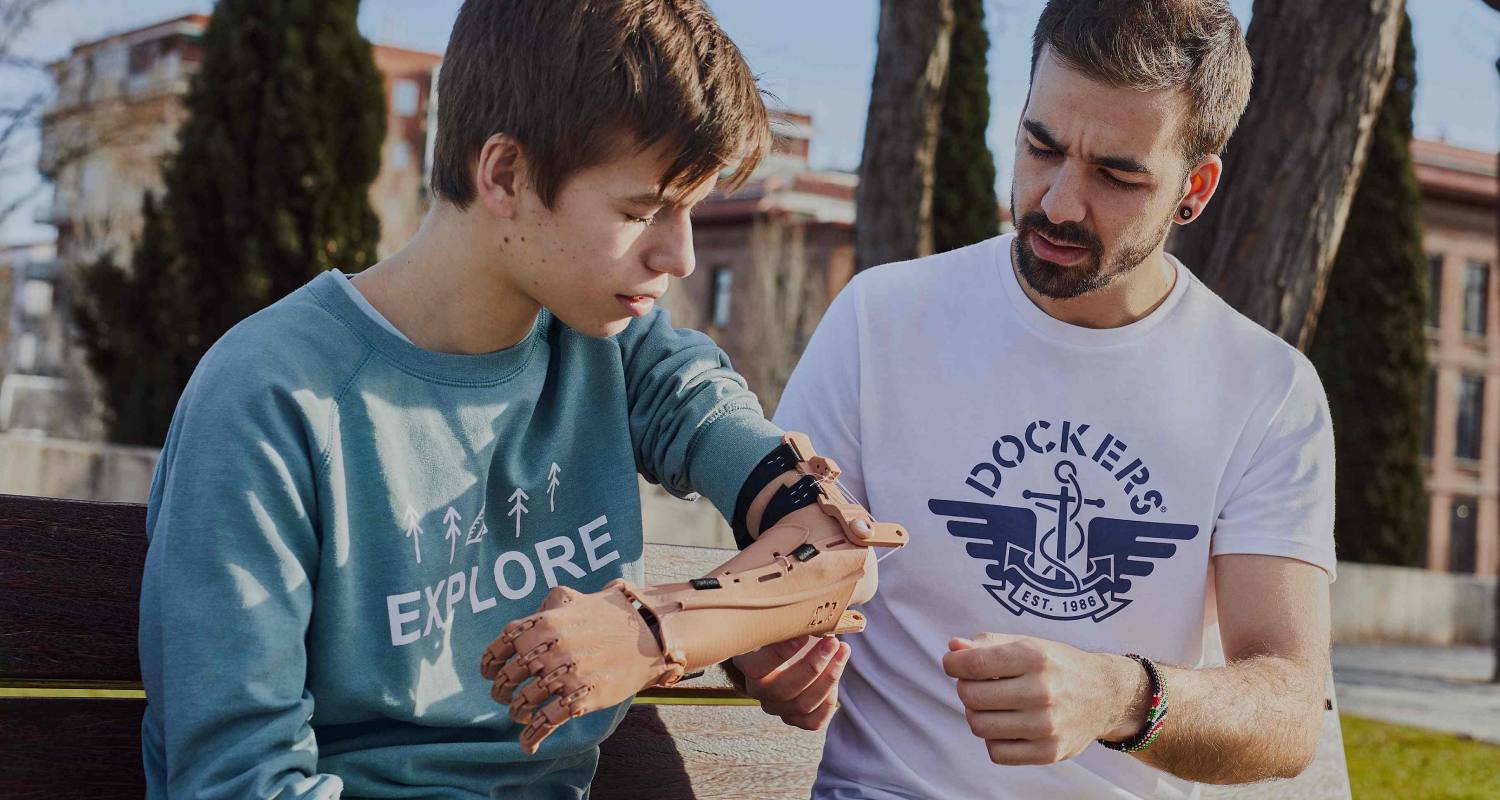
3D printing at the service of people
3D printing at the service of people

3D-printed arms: A second chance for people with disabilities
3D technology and recycled plastics to help people
In 2017, during his last year as an Industrial Engineering student, Guillermo Martínez made a trip to Kenya that changed his life. His initial plan was to take part in a volunteering program in an orphanage in the African country. "At the time I was learning in my spare time about 3D-printing technology, which was booming, and how to apply it to creating prosthetics for people with missing limbs. And I thought that could be another way to help," Guillermo stated.
There were already devices for people without fingers, but not for those missing an elbow, so in the months prior to the trip he designed and manufactured the first plastic arm for the elbow with his 3D printer, which, with a mechanism of gears and threads and without the need for electronics, allows you to open and close your hand to pick up objects.
Guillermo got in touch with five people in Kenya who needed that aid, printed the prosthetic arms adapted to their needs in Madrid, and put them in his suitcase to donate to them. "Everything worked so well when we tested them," Martínez recalls. "I said to myself: I can't only keep these five aids. And that's how the idea of founding the NGO Ayúdame3D was born."


More than 500 people from around the world now use prosthetics printed by the social startup Ayúdame3D.
Today over 500 people use one of the 3D-printed devices that this social startup gives out for free in 55 countries, including Spain, Kenya, Mexico, and India. "In the world there are 83 million men and women who can't afford a prosthetic and our aim is to make these devices more accessible," the founder and director of Ayúdame3D continued. Their 'Trésdesis', as they have dubbed these 3D-printed plastic aids, are durable and easy to maintain without relying on electronics, making them more functional in places where spare parts or a battery are not readily available.
500+
arms
printed by Ayúdame3D
55
countries
have recieved this type of prosthetics
500
grams average weight
of a 3D-printed arm
30-40
number of parts
of a 3D-printed arm

3D printing at the service of people
More independent lives
From old monitors to aid devices
The manufacture of the three types of prosthetics that the NGO produces today, for the wrist, elbow, and shoulder, are part of some standard 3D models that are adapted to create a device customized to the measurements and requirements of each receiver. "It is a process of 'digital craftsmanship'", Martínez explains, because the design is printed in pieces, about 30 or 40 per Trésdesis, and the final assembly has to be done manually, connecting and tightening the cables and mechanisms that allow the movements.
The prosthsetics are manufactured with different types of plastic, such as PLA or TPU, accessible and easy-to-use materials in 3D printing that allow the size, resistance, flexibility, and weight of each part to be configured depending on its function to create some devices that are 100% adapted to each user. "Those qualities are only brought to us by 3D-printed plastic," Martínez continues: "Sometimes we think of plastic as something disposable that we shouldn't use so much, but when it comes to making a device that a person will use for a lifetime, it is most efficient to use this lightweight and durable material."
4,000 parts from monitors donated by Repsol have been recycled into filament for the 3D printing of 5 prosthetic arms.
Ayúdame3D don't stop making improvements to the prosthetics and are now testing with a very resistant type of plastic, ABS, which is also used to manufacture things such as toys and plugs, and "which have some very good properties so that our devices have less wear with movements and are adapted to countries with some more adverse social or weather conditions." In collaboration with Repsol, Elix Polymers, and the Leitat Technological Center, they have recycled 4,000 ABS parts extracted from computer monitor casings discarded by the energy company, which have been processed into 3D-printable plastic filament, which the startup will turn into 5 prosthetic arms for delivery during 2023.
This collaborative circular economy project summarizes, for Martínez, "the possibilities for efficient processing of plastics." Recycling these monitors, giving a second life to the plastic, is going to make it possible "for someone who needs one of these devices but can't afford it to have a more independent existence."

Technological volunteering from home
The NGO has more than 100 collaborators, the 'Helpers3D', who contribute their individual printers.
To attend to as many requests as possible, Ayúdame3D has the backing of a network of around 120 collaborators in Spain. They are the 'Helpers3D', who have experience in the use of 3D printing and technologically volunteer their home printers to manufacture prosthetics, "turning what was their hobby or passion into a way to help."
Prosthetics can be requested through its website and through the social organizations that it cooperates with in different countries and which act as ambassadors locating potential recipients, placing the 'trésdesis' on the beneficiaries, and following up to help with the minimum maintenance required. In addition, the startup is promoting a volunteering platform that will allow occupational therapists, via videoconference or in person, to train the recipient in the use of the device to improve their daily routine.
Ayúdame3D also manufactures other products with this technology, such as "Chemobox', boxes with colorful images of superheroes or cartoons that cover the chemotherapy bag used by children in hospitals or pill boxes for people with Parkinson's disease. With the social use of 3D printing, "we are helping these people gain in dignity and quality of life, something quite spectacular, that I had never imagined and which motivates you to continue working and innovating in this field," reflects Martínez on the human side of his work. "We will continue to look for social uses for plastic that improve people's daily lives."
Biotechnology
Applications, types, and advantages of this science that seeks to improve people's lives.

What is home automation?
Do you want to know what advantages it has for your home?